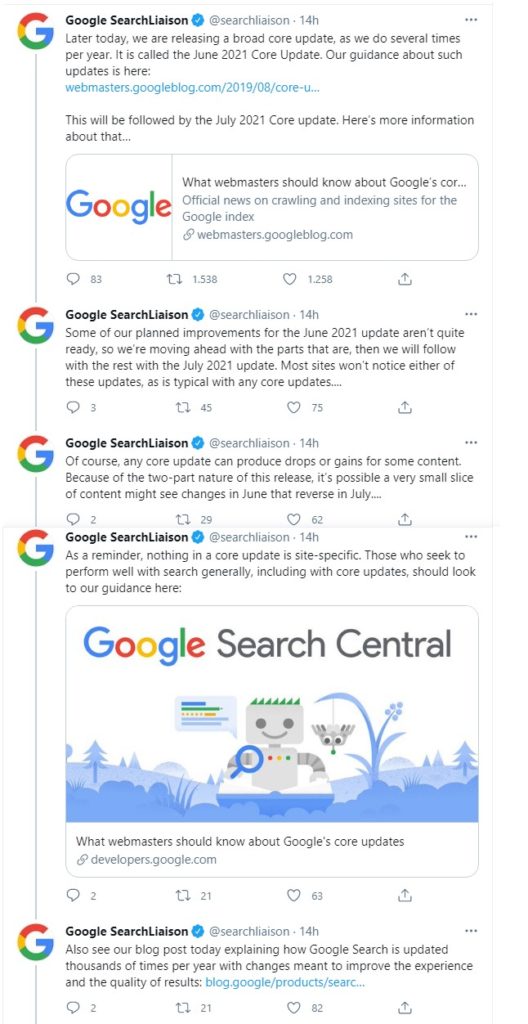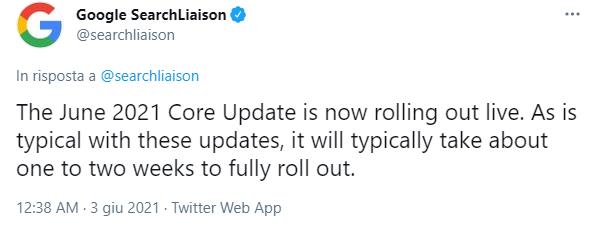Google releases the June 2021 Core Update (and that is not all)
It is one of the most anticipated moments of the year, but when it finally arrives we are still baffled: we talk about the release of updates to the Google search algorithm, which continue to be seen with a mixture of feelings from the SEO community, divided between those who hope for an improvement and those who, probably the majority, fear possible negative shocks for their projects. Anyway, a few hours ago the June 2021 Core Update was launched in the United States, the first of the year (the previous was in fact the December 2020 Core Update), but it is not the only news announced by Mountain View.
Google June 2021 Core Update has started
As tradition, by now, right before the release of the algorithm we have a tweet by the @searchliaison account: at our midnight (7 p.m. of June 2nd, for the ET time zone) came the communication about the start, which will then became effective about five hours after (5.30 a.m. for us, 0.38 in the United States).
This update will have a global implementation, an impact on all languages and will take about two weeks to complete.
Compared to the past, the chirping contains an important news: in addition to referring to the guide on how to respond to a Google core update, this time the company also announces a second update of the basic algorithm that will happen already next month.
Google July 2021 Core Update is ready
As Danny Sullivan (the person behind the @searchliaison account, as we know), explains, “some of the improvements planned for the June 2021 update are not yet ready”: for this reason, Google decided to immediately release “the parts that are ready” and to “continue with the rest through the July 2021 update“, already christened July 2021 Core Update.
Google updates, what to expect
It is always Sullivan to reassure us about what may be the effects of such updates: to use his words, “most sites will not notice any of these updates, as is typical of any core update”. However, he also admits that “every update can produce declines or gains for some content”, and “because of the nature divided into two parts of this release, it is possible that a tiny slice of content can see changes in June that are reversed in July”.
Historically, Google releases a “core” update every quarter, although last year the timing was upset by the pandemic, with well 7 months between the May 2020 Core Update and the December 2020 Core Update, followed by another 6 months before the current one.
According to Sullivan, one of the reasons that led to the delay of the June 2021 Core Update is its complexity, which has even made it necessary to divide the intervention into two parts – and, therefore, it is possible that the scope of this update is rather extensive, recalling also that this month should officially start the Page Experience Update (scheduled for the second half of June).
As with any other algorithmic update, the positioning of our pages may increase, decrease or remain stable; compared to the past, Sullivan has already told us that if the site is interested (in one way or another) from the June 2021 update could also reverse the trend with the next July 2021 core update, so it’s not yet time to jump for joy or swaddle your head, depending on the effects.
In fact, the “traditional” advice is valid: do not intervene hoping to correct parts of the site in a random way, but try to work on the quality of content and the experience provided to users, which are the elements that Google requires our pages. The updates, in fact, are not designed to “hit” a site or a type of sites, but is useful to improve the quality of the responses of the search engine results.
So, there are no specific actions to take to recover from a drop after an update and, in fact, a negative impact on placement might not mean that there is something wrong with our pages. Quoting the article again, these are not pages that “violated the guidelines for webmasters nor were subject to manual or algorithmic actions”, because “there is nothing in a core update that targets specific pages or sites”. Instead, the changes concern the improvement of the way “our systems evaluate content in general: these changes could bring out some pages that were previously under-rewarded”.
The reason why behind Google’s updates
Sullivan also wrote a blog post in conjunction with the June 2021 Core Update, in which he explains how and why the search engine makes these changes to its system.
Google receives “billions of queries every day from countries around the world in 150 languages”, and to remain competitive and serve its user base it must continually seek to improve: “Delivering great results with this type of scale and complexity requires many different systems and we are always looking for ways to improve these systems, so we can view the most useful results possible”, says the Public Liaison for Search.
Just like “computers, smartphones and apps are regularly updated, the same thing happens with Google Search”, which “is updated thousands of times a year with changes intended to improve the experience and the quality of the results”, summarizes the author.
Compared to the technologies mentioned, then, the search engine has to deal with another factual reality: “The web grows, sites change, content is published constantly”, and “when new sites emerge and the Web changes, continuous updates are crucial to ensure the support of a wide range of publishers, creators and companies, while providing users with the best information available“.
Lots of interventions to improve the quality of results
And so, along with broad core updates like today’s – which are announced officially and in advance – there may also be more limited updates, and even in a single week could “implement dozens of updates that aim to improve your search incrementally” (which is why you can’t “share details about all” updates, but only the major ones).
The effect of this work is seen concretely: for example, Sullivan recalls, “evaluation processes show that we have reduced the number of irrelevant results that appear on a search results page by over 40% in the last five years”.



